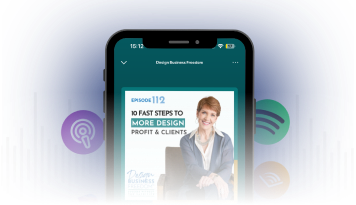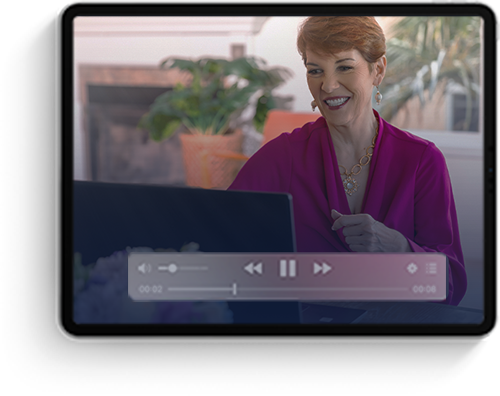Delegate to Elevate: How Interior Designers Can Get More Done in Less Time
If you’re still telling yourself, “It’s just faster if I do it,” then delegation isn’t your problem—control is.
And I get it. When I started my design business, I thought no one could do it quite like I could. That mindset left me stuck, stressed, and stretched way too thin. Delegating changed everything: I earned more, had more freedom, and reclaimed my creativity.
EPISODE HIGHLIGHTS
3:00 — “Why delegation is not a weakness, but a leadership move”
8:15 — “The Zone of Genius test: how to know what to keep”
12:40 — “Time-sucking tasks to delegate right now”
22:00 — “How to delegate clearly and effectively”
31:30 — “What not to delegate and why it matters”
Whether you’re a solo designer juggling it all or running a boutique team and wondering why you still feel buried, it’s time to shift out of doing everything mode and step into your role as Creative Director and CEO.
If you’ve been hesitant to embrace delegation for interior design firms, this is your sign—it’s not just a smart move, it’s essential to scale with sanity.
Here’s how to delegate with clarity, confidence, and intention.
Delegation Is Smart Leadership
Let’s shatter the myth that delegation is a weakness. It’s not. It’s leadership in action.
If any of these sound familiar…
✔️ “It’s faster if I just do it.”
✔️ “No one else will care like I do.”
✔️ “I can’t afford to hire help.”
…then you’re thinking short-term. That mindset is exactly why you feel stuck.
Here’s the truth: the right hire gives you back your time—which is worth a whole lot more than what you’re investing in your team. You should be focused on the $500–$1,000/hr value tasks, not the $10–$100/hr ones. Even if your client-facing hourly rate is $150, your strategic brain and genius talent are worth far more. Own that.
Delegation for interior design firms isn’t just about productivity—it’s a long-term growth strategy. The more you step into your true role, the more your business reflects your vision without burning you out.
The Real ROI of Delegation
When I was coaching my client Megan—an incredible globe-trotting designer—she was paying her VA $50 an hour. Today, it’s closer to $65. And that VA runs her invoicing, procurement, and all the admin that used to keep Megan buried. Megan now spends her time doing what only she can do: designing brilliantly and nurturing priceless relationships.
Delegation isn’t about giving up—it’s about going up. You’re building a firm you can step away from, even for a week or two, without it falling apart. That’s what it means to operate as a CEO, not merely the owner.
Find Your Zone of Genius
Here’s your test: Your Zone of Genius is any task that checks three boxes:
✔️ You’re brilliant at it
✔️ You absolutely love doing it
✔️ You’re fast and efficient at it
That’s where your time should go. The rest? Delegate it.
Designers often hold onto tasks like CAD, rendering, or procurement because they’re “part of the process.” But if they don’t meet all three criteria? They’re draining your energy—and your bottom line.
Delegation for interior design firms means being intentional about protecting your energy and profitability. It’s not about outsourcing everything—it’s about choosing what only you can do and handing off the rest to someone who can do it better, faster, and with less stress.
What to Delegate
Start with the time-suckers. These are the tasks that chip away at your energy and eat into your strategic time.
✔️ Repetitive tasks: email, calendar management, order tracking
✔️ Admin work: client onboarding, invoicing (especially hourly billing), file organization
✔️ Tasks that don’t require your creative or strategic input
And here’s the kicker: many of these are simply habits. You’re doing them because you always have—not because you’re the best one for the job.
So ask yourself daily: What do I wish I had delegated today?
Be honest. You don’t get points for burnout.
Who to Delegate To
Your existing team is the first place to look—but be strategic.
✔️ Don’t overload your top performers. That’s not a reward—it’s punishment.
✔️ Give your VA more responsibility, like inbox triage or file organization.
✔️ Let your junior designer step into more creative leadership.
Delegation is also a powerful growth tool. Frame it as a trust move, not a task dump. And ask your team what they want to learn, what tools they need, and where they want to grow. When you support their development, your business grows with it.
And don’t forget AI. You don’t need to outsource everything to a human. AI can help with:
✔️ Writing newsletters or blog posts in your voice
✔️ Organizing content and tasks
✔️ Streamlining marketing workflows
Designers aren’t using AI enough on the business side—and you’re leaving hours on the table because of it.
How to Delegate Effectively
This is where most designers fumble.
To delegate with success:
✔️ Define what “done” looks like—with examples
✔️ Set a real (or padded) deadline
✔️ Provide context: why the task matters
✔️ Offer resources: never assume they have what they need
✔️ Establish check-ins: not to micromanage, but to track milestones
Use tools—Slack, Trello, Asana, Google Sheets. Find what works for you and use it consistently. Delegation without structure is a train wreck waiting to happen.
Delegation for interior design firms is most successful when it’s supported by systems. You can’t just hand things off and hope for the best—clarity, timelines, and communication are everything.
And above all: make delegation a weekly habit, not a last-minute scramble.
What Not to Delegate
There are a few tasks only you should own:
✔️ Vision and brand direction
✔️ Key client relationships (unless you’ve hired a client concierge)
✔️ Final design decisions (unless your team is trained to your standards)
✔️ Strategic planning
These are the heartbeat of your business. Stay here. Build systems and support so you can stay here.
Your Action Steps
You’re not meant to do it all. There’s no prize for being busiest—and burnout will steal your creativity and your profit if you let it.
✔️ Audit your week
✔️ Identify what zaps your energy
✔️ Create one job description (even partial)
✔️ Start delegating one or two things this week
I’ll leave you with this: Don’t let a bad hire from your past scare you off future growth. Mistakes happen. Learn, adjust, and try again. I call it catch and release—and it’s part of building a team that actually elevates you.
Your talent is too precious to be spent on the wrong tasks.
If you’re serious about growth and ready to take action, coaching will accelerate your success. It starts with a confidential Design Business Assessment—a complimentary session where we’ll take a close look at your design practice, where you are, and where you want to be. We’ll put together a plan to close the gap.





